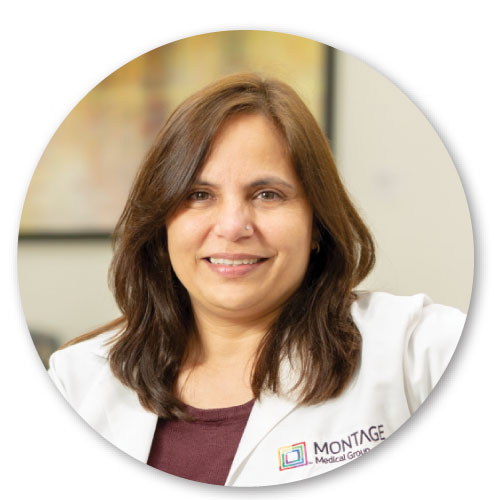
Trouble swallowing? A common concern that can relate to age, illness, or injury
One in 25 people experiences problems swallowing each year; for most, it’s a temporary issue that resolves on its own.
But for others, it can be serious and even life-threatening.
Difficulty swallowing, called dysphagia, can have many causes and becomes much more common as people age.
“It’s a natural, progressive symptom that happens as we get older,” says Maria Flores, a speech language pathologist at Community Hospital of the Monterey Peninsula. “People 75 and older often experience presbyphagia, a loss of muscle mass in their swallowing muscles.”
“We see it in all ages, but dysphagia is most often seen in elderly people, even those who do not exhibit many symptoms, which can be as simple as more-frequent heartburn or food particles coming back into the mouth,” says Dr. Nupur Sinha, a pulmonary and critical care specialist at Montage Medical Group in Monterey.
OTHER SYMPTOMS INCLUDE:
- Pain when swallowing
- Inability to swallow
- Feeling as though food, liquid, or pills are stuck in the throat or chest
- Feeling as though there is a “lump” in the throat
- Inability to keep lips closed, leading to drooling
- Food or stomach acid coming back into the throat
- Food or liquids leaking from the nasal cavity
- Difficulty coordinating breathing and swallowing
- Coughing or gagging when swallowing
- Lung infections like pneumonia
- Hoarse or changing voice
- Aside from aging, dysphagia may
"We see it in all ages, but dysphagia is most often seen in elderly people, even those who do not exhibit many symptoms, which can be as simple as more-frequent heartburn or food particles coming back into the mouth."

— Dr. Nupur Sinha, pulmonary and critical care specialist, Montage Medical Group
“We have to be good detectives to see where the dysphagia is coming from, and how we can best treat it,” Flores says.
The search for a cause typically includes a comprehensive review of the person’s medical history; a physical exam; and tests that could include a chest X-ray, a CT scan, a functional X-ray of swallowing called a modified barium swallow study (MBSS), or a fiberoptic endoscopic evaluation of swallowing (FEES), in which a thin, lighted, flexible tube is passed through the nose to see what happens during swallowing.
In the MBSS study, foods of different consistencies are coated with barium, a contrast material that shows up on X-rays. Images are made as the patient swallows the foods, to identify problems with coordination of the mouth and throat muscles and to determine whether food is going the correct way.
The exam and tests can uncover a wide range of causes, from damage from acid reflux to a narrowed esophagus. Treatments are just as wide-ranging,
“A mechanical cause can be mechanically treated,” Sinha says. “If the passage is narrowing, we can use small dilators to open that area. If it’s more of a nerve or muscle dysfunction, we target the treatment on those areas. Stroke patients, for example, can often strengthen their nerves and muscles through rehabilitation.”
Other treatments include medications, such as a prescription to reduce stomach acid; surgery to remove a tumor or repair damage; and changes in diet, including the volume and pace. Speech and swallowing therapy are also effective treatments.
Flores and other speech language pathologists at Community Hospital provide therapy to help people coordinate swallowing muscles or stimulate the nerves that trigger the swallowing reflex. They may also teach ways to place food in the mouth and position the head and body to make swallowing easier.
People with dysphagia sometimes attempt to self-treat the affliction by eating only soft, minced foods and reducing their intake of fluids. But Flores says this can lead to dehydration or malnutrition, and a hospital visit.
“The challenge, then, is to figure out a good way for them to hydrate without coughing or choking, and to get them stable enough to leave the hospital,” Flores says. “Eating and drinking with an acute swallowing impairment is going to compromise the lungs, as well as physical abilities: The longer you stay in bed, the weaker you get. And that can eventually become life-threatening.”
Pneumonia, according to Flores, is a serious complication of a swallowing impairment, particularly aspiration pneumonia — a lung infection that develops after a person aspirates (inhales) food, liquid, or vomit into the lungs. A person can also aspirate food or liquid from the stomach that backs up into the esophagus.
“Aspiration pneumonia can be difficult to treat, especially if it’s a recurrence,” Flores says. “With these patients, we do a very thorough swallow-study evaluation to see where the swallow function is breaking down before we start them on any kind of rehabilitation pathway.”
Other complications of dysphagia can include weight loss, respiratory infections, fatigue, cognitive confusion, and feelings of isolation, anxiety, and depression. By addressing the fundamental issues contributing to the dysphagia, speech language pathologists can help their patients manage these complications.
“Our team is dedicated to returning our patients back to a functional baseline while focusing on quality of life and safety,” Flores says. “We love the work that we do because we are making a big impact in people’s lives.”

